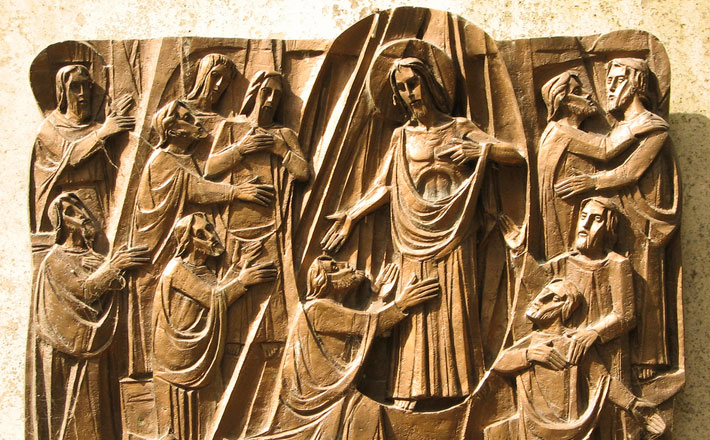Commentary on John 20:19-31
Easter is supposed to be a season, not a day, but it’s hard to deny the letdown that comes on the Sunday after the Big Event.
At the grocery store, lilies and chocolate eggs have found their way to the discount rack. There are no fancy hats or new clothes this week. All across town there is plenty of good parking at church again. In thousands of ordinary churches, the ordinary faithful gather on no particular Sunday to listen again to the story of Thomas who wouldn’t believe without proof.
It’s the perfect text for the Sunday after Easter. For one thing, the main action of the story takes place exactly one week after that first Easter Sunday (John 20:26). But what truly suits the story to the occasion is the subject matter: on the Sunday after Easter, as countless, colorful unfound eggs lie moldering in their hiding places, even the faithful must come to terms with hidden doubts, and decide if faith is real enough for ordinary time.
Our point man on the Sunday after Easter is a guy named Thomas. We have designated him “Doubting” and given him a bad rap, but the truth is that on the Sunday after Easter he is our go-to guy. We send in Thomas on days like this. For such occasions we call in the hard-nosed skeptic — somebody brash enough to poke around a bit and see if this thing will really hold water.
So when we read that Thomas refuses to believe in resurrection based on mere hearsay — when we hear again his demand for physical proof, we are of two minds, I think. Our proper, church-going, religious selves wag a knowing finger at Thomas. “Shame on you! And you call yourself an apostle!” But another part of us thrills at the words of our champion: “Unless I see the mark of the nails in his hands, and put my finger in the mark of the nails and my hand in his side, I will not believe” (John 20:25). Yes! Yes, and why not? If it’s true — and we’re not saying it’s not true — but if it is true, why can’t we have proof? We want to see. We want to touch. We want to be there.
If only we had been there when Peter entered the tomb and found it empty except for what? The linen head-wrappings neatly folded and laid aside. What an intriguing detail! If only we had felt our own hearts ignited by the words of the stranger on the road to Emmaus. If only Jesus had been revealed to us that evening in the breaking of the bread. Or the road to Damascus — we would prefer even the road to Damascus to no proof at all. We would have gladly changed places with Saul — endured the dagger thrusts of divine light that stabbed out his sight and cut him loose from the only life he knew. We would be Saul, writhing blind in the dust — his world unmade for now, but all the possibilities of Damascus looming on the horizon. We would gladly endure it, because then, at long last, we would be sure. Or even just to be a face in the crowd — one of the anonymous onlookers when our Lord appeared to more than 500 believers who had gathered in one place, as 1 Corinthians 15 tells us. In short, we understand Thomas perfectly. We, too, want to be there. We want proof. A part of us cheers him on when he sets his terms for belief: “Not unless I see … not unless I touch.” You go, Thomas!
Indeed, this desire for experiential proof is completely normal. The longing for evidence is not the special burden of believers living in an age of science. Thomas was not the only disciple who wouldn’t take someone else’s word for it. Earlier in this very chapter, Mary announced the good news of resurrection to the disciples (John 20:18), and yet when Jesus came to them that evening he found the doors locked in fear, and offered to each of those present the same signs that Thomas would later demand (v. 20).
Proof is what everyone prefers. But we must come to terms with our place in history. God, in God’s manifold wisdom, has not ordained that we should “be there” no matter how sincerely and audaciously we wish it. We live in an age of wonders, no doubt, but when it comes to resurrection faith, ours is not the dispensation of sight.
Instead, God has given us the chance to be blessed according to the last of the beatitudes. “Blessed are the poor,” said Jesus, and yet the least well off among us are wealthy by any realistic historical or global standard. “Blessed are you who hunger,” and yet we are only hungry when we are dieting. “Blessed are the meek,” and yet we can scarcely avoid pride at all that we have achieved. No, this last beatitude may be our best shot at the designation “blessed of God.” Blessed are they who can’t be absolutely sure. Blessed are they who believe the hearsay. Blessed are the eyes of faith that continue in hope despite the frustrations and ambiguities. “Blessed are those who have not seen and yet have come to believe” (John 20:29).


April 12, 2015